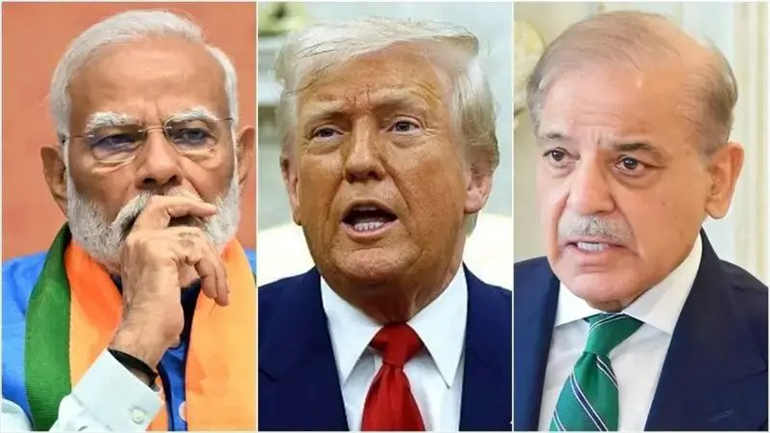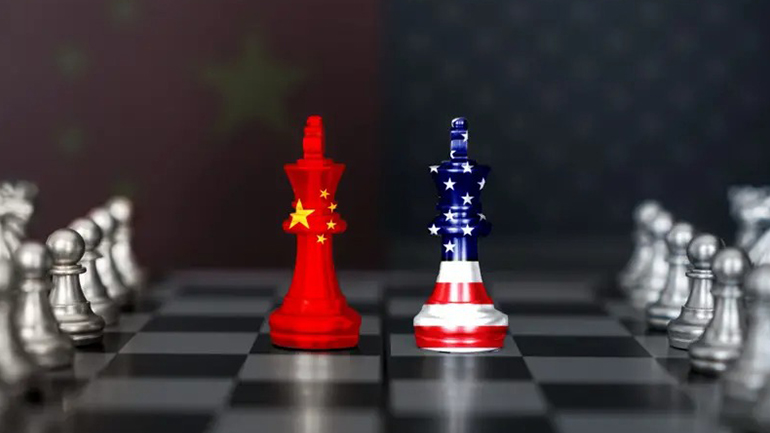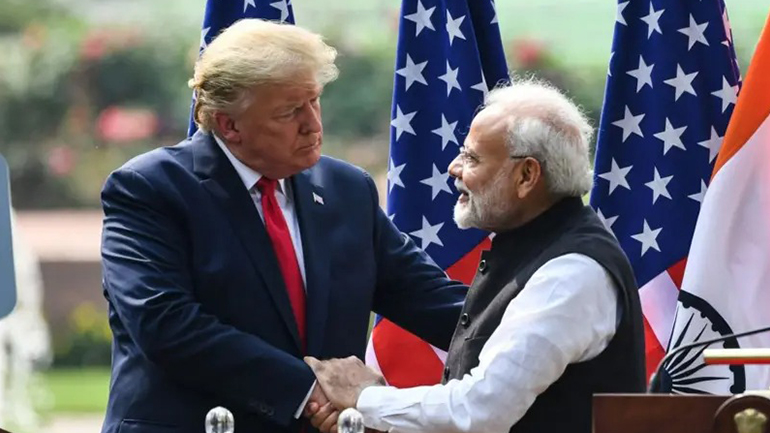

Politically, diplomatically, and militarily, the past three weeks have been extremely turbulent for South Asia's two key nations, India and Pakistan. On April 22, an attack by armed militants in Pahalgam, located in Indian-administered Kashmir, resulted in the deaths of 26 tourists. In response, India carried out airstrikes in Pakistan and Pakistan-administered Kashmir. This was followed by four days of aerial skirmishes and shelling between the two countries, pushing the region to the brink of a dangerous conflict. By the morning of May 10, both nations had reportedly launched missile strikes on each other’s military air bases, and the tension was escalating rapidly. Both sides were claiming to have inflicted heavy damage and thwarted enemy attacks. Then, unexpectedly, on the afternoon of May 10, U.S. President Donald Trump issued a statement on social media announcing a ceasefire between the two countries. He declared on social media that, with U.S. mediation, India and Pakistan had agreed to a "complete and immediate ceasefire" after four days of intense cross-border clashes.
Later, in another message, President Trump said, “I will work with both of you to find a solution to the Kashmir issue.” Just 15 days earlier, Trump had described the rising tensions between India and Pakistan as “their internal matter.” It is worth noting that on April 25, following the Pahalgam attack, when tensions were escalating between India and Pakistan, U.S. President Donald Trump had stated that the two countries would “resolve the tensions themselves.” Similarly, on April 30, U.S. Secretary of State Marco Rubio contacted both India and Pakistan and urged Pakistani officials to cooperate in the investigation of the brutal attack. U.S. Vice President J.D. Vance, in an interview with Fox News on May 1, said, “We hope India responds to this terrorist attack in a way that does not trigger a broader regional conflict.” However, during the ongoing tensions between the two countries, in an interview given on May 9, he stated that the U.S. would not intervene in the India-Pakistan conflict because “we fundamentally have nothing to do with it. We can't tell India and Pakistan to lay down their arms.”
But then, on the afternoon of May 10, everything suddenly changed. First, U.S. President Donald Trump took credit for mediating a ceasefire between India and Pakistan, and later he spoke about promoting trade between the two countries. In his statement, he also mentioned resolving the Kashmir issue. In India, political and social circles criticized Trump's remarks as interference in India's internal affairs. However, whether in Saudi Arabia, on a visit to Syria, or in the UAE, Trump has repeatedly taken credit for brokering peace between Pakistan and India. On May 12, while speaking at the White House, Trump said, “On Saturday, my administration mediated an immediate and complete ceasefire between India and Pakistan. I believe this is a permanent ceasefire. It has ended a dangerous conflict between two nuclear powers.” Trump also claimed that he played a key role in the resolution through trade and tariffs.
Trump’s mediation offer on Kashmir has put India in a difficult position.
The U.S., diplomatic backchannel contacts, and major regional players: How two nuclear powers on the brink of war were brought to a ceasefire.
88 hours of dangerous tension and a sudden ceasefire: What lies ahead after missile exchanges between India and Pakistan?
The nuclear agency denies radiation leak in Pakistan: What’s the truth behind the rumors circulating in India?
Then, on May 14, during a visit to Saudi Arabia, Trump once again spoke about facilitating a ceasefire between India and Pakistan. He said, “Relations between Pakistan and India are improving. It’s possible the U.S. could bring both countries’ leaders together.” President Trump added, “We told both leaders—let’s make a deal, let’s do some trade. Don’t fire nuclear missiles—trade the goods you’re so good at making instead.” According to Reuters, on May 15, while speaking to U.S. troops at a military base in Doha, Trump again stated that the India-Pakistan conflict was over and urged both nations to focus on trade instead of war, a move that both countries welcomed. This sudden shift in U.S. policy, from non-involvement in the conflict to mediation, ceasefire, and promoting trade, is being closely watched by political and diplomatic circles around the world. What is the U.S. President hoping to achieve by bringing two traditional rivals from the brink of nuclear war to the negotiation table over trade? In this piece, we try to explore the significance of Trump’s statements and what the U.S. President wants from India and Pakistan, based on views from various observers and analysts

President Trump said he had 'told the leadership of both countries to make a deal'
Washington-based analyst Michael Kugelman says every statement made by Trump regarding India and Pakistan is significant because he is the President of the United States. This reflects the ongoing US role in India-Pakistan tensions and growing global interest in Trump’s approach to nuclear tensions in the region. However, Kugelman also cautions that "it would be a mistake to overstate President Trump’s remarks, as they do not appear to be part of any formal policy," suggesting a gap between rhetoric and actual Trump Kashmir policy. He adds that Trump considers himself a "deal maker," which is why he is interested in reducing tensions between Pakistan and India—a strategy often described as Trump’s deal-making diplomacy. "Improving relations between Pakistan and India is not a new goal for the U.S. Washington has always, in principle, supported better ties between New Delhi and Islamabad," aligning with broader US mediation in South Asia and long-term Trump’s foreign policy goals. However, according to Kugelman, "meaningful dialogue won’t happen as long as the focus remains on the part of Kashmir controlled by the other party. That is what makes initiating talks so difficult." This underscores the complexity of Trump and the Kashmir dispute. He continues, "There might be room for discussions on other issues, but given the current diplomatic climate, it does not seem likely." Thus, the prospects of successful India-Pakistan conflict resolution remain uncertain. Zeba Fazli, a research analyst affiliated with the Stimson Center, said that President Donald Trump takes great pride in his “deal-making” abilities and applies this mindset to foreign policy and conflict resolution, again reinforcing the theme of Trump’s deal-making diplomacy.
Referring to Trump’s recent comments in Saudi Arabia about trade with India and Pakistan, Fazli said, “Such comments may indeed be attempts to bring India and Pakistan to the negotiating table, but it remains to be seen how trade between the U.S. and Pakistan, and the U.S. and India, will grow in the current economic environment and which products will be involved,” reflecting the shifting US interests in South Asia. When asked what the U.S. President wants from India and Pakistan, Zeba Fazli responded, “Just a few days ago, President Trump said that millions could have died in a conflict between India and Pakistan. This indicates that he was concerned about a potential nuclear war between the two countries, shedding light on Trump's India-Pakistan relations. “India-U.S. relations have grown closer over the past several years, and under Trump’s first administration, security cooperation and trade between the two countries increased. The U.S. views these developments as essential to counter China’s influence in the region.” Fazli further added, “To counter China, it is important that India not be caught in a conflict with Pakistan.” According to the Stimson Center research analyst, U.S.-Pakistan relations have experienced fluctuations since the withdrawal of U.S. troops from Afghanistan. “Trump’s comments about mediation in the India-Pakistan crisis suggest that the U.S. still has an interest in Pakistan, and the offer of mediation gives the impression that the U.S. stance is closer to Pakistan’s historical position on Kashmir than to India’s,” again aligning with the larger picture of US mediation in South Asia and Trump and the Kashmir dispute. Zeba Fazli said, “Trump’s mediation offer is likely to increase concerns among certain factions within India’s policy establishment who have long viewed the U.S.-India partnership and India’s reliance on America with suspicion.”

I believe President Trump’s mediation in South Asia and statements reflect his desire to take credit for the India-Pakistan ceasefire and his broader wish for a peace deal,” says one observer. She adds, “Trump had spoken about resolving the Kashmir dispute during his first term, which India did not support. While claiming credit for the ceasefire, Trump praised both Indian and Pakistani leaders and spoke of both countries on equal footing—something that angered India but pleased Pakistan.” “This is significant,” she explains, “because in recent years, U.S.-India relations have become much stronger compared to U.S.-Pakistan relations.” Meanwhile, Swasti Rao, an international affairs expert, says, “President Trump is always in a hurry to make a deal, which is why his Trump foreign policy on India and Pakistan is full of confusion.” She continued, “Trump has very little understanding of history. From the Russia-Ukraine war, the Iran deal, the Middle East situation, to the Trump Kashmir peace talks and the India-Pakistan conflict, he's rushing to strike deals just to take credit. He wants to win a Nobel Prize.” Criticizing Trump’s approach to India-Pakistan tensions, Swasti Rao said, “It wasn’t just the U.S.; countries like Saudi Arabia, Iran, and the UAE were also making behind-the-scenes efforts at US diplomacy in South Asia. But in this case, Trump crossed a diplomatic line that should not have been crossed. It undermines trust between allies.” She pointed out, “Trump abruptly paused aid to Ukraine for a few days. That shocked European countries, leading them to start strengthening their militaries.” “President Trump has disrupted the balance,” she added. “You can’t be sure what he will say to friends or foes.” On the other hand, Rabindra Sachdeva, President of The Image India Institute, does not believe that Trump’s foreign policy is full of confusion. He says, “Before Trump, the average U.S. trade tariff was around 2.5%, while India’s was around 12%, and China and the EU’s around 8%. Trump raised U.S. tariffs from 2.5% to 10%. People think he’s flexible on tariffs, but it’s actually in America’s favor.” Sachdeva adds, “There were threats to suspend military aid to Ukraine, which caused a huge uproar, but eventually Trump signed a major mineral deal with Ukraine. That shows how he was working for U.S. interests all along.” He believes, “We shouldn’t focus on the language Trump uses. We need to change our lens when looking at Trump and the U.S. Trump is redefining the power of the U.S. presidency, and he doesn’t care what others think—because he knows America is a superpower.”

Powered by Froala Editor